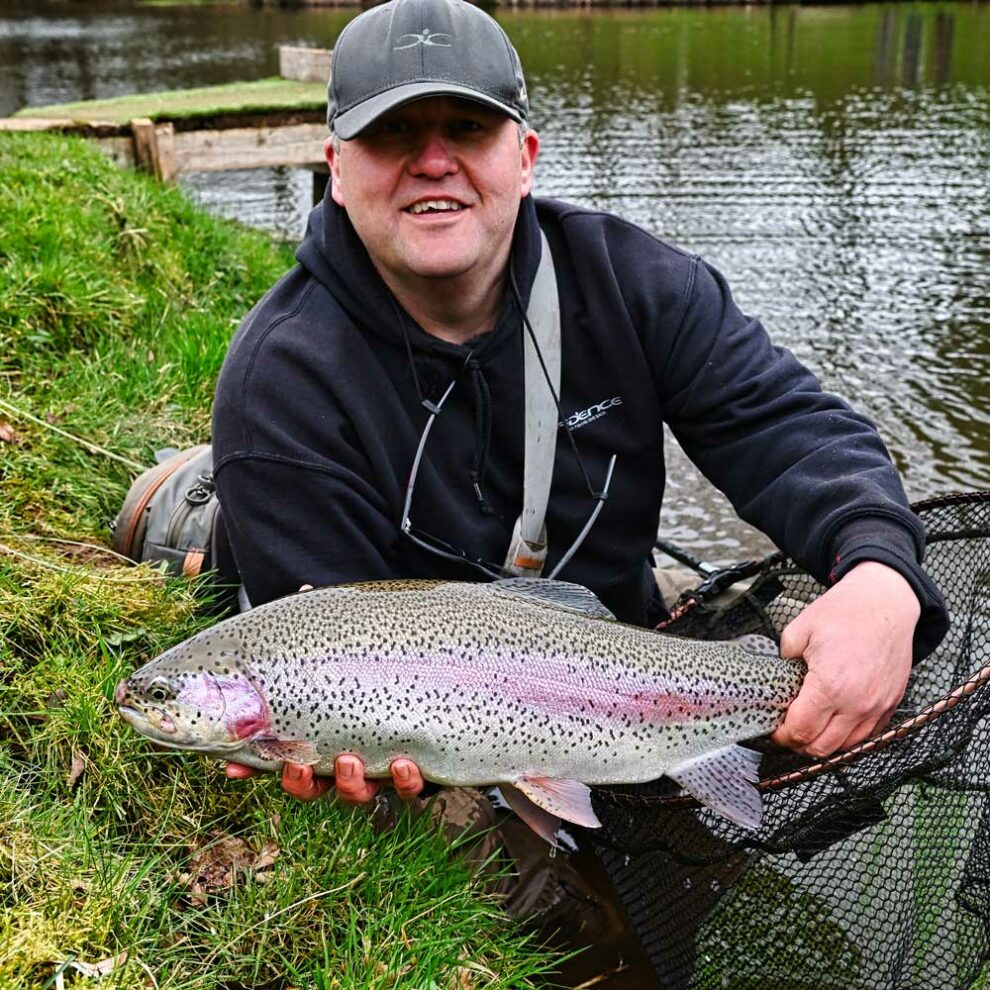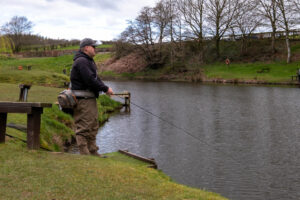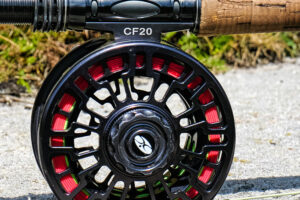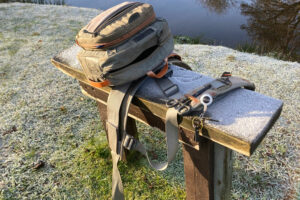This is the hardest top ten fly list of the whole year for a reassuringly good reason – Spring is the best time of year to be fishing the UK’s small waters.
Nature begins to wake up and deliver the trout a much bigger menu of natural flies. The water remains at a fairly fish friendly temperature and the fish are peckish following a lean winter. Every fly in your box is in the game, from gaudy lures right down to tiny dry flies.
Spring is probably most famous for Buzzer fishing. A really addictive method where the take can be brutal.
Every lake and every day are different, but if I were to pinpoint prime time for Buzzers, it would be April. In March, I’ve had a couple of days when the fish are obviously switching on, but not fully tuned in yet. By that, I mean there are parts of the day when the fishing is hectic and then literally nothing before or after.
In other words, if you’ve tried fishing buzzers in the morning and had nothing, don’t dismiss using them later in the day. The afternoon is probably the best time, but in truth, buzzers can be on the move at any time. It shouldn’t take more than a couple of casts to see if it’s a green light method.
Another thing spring is excellent for is hatches of terrestrials. Land born insects that get blown onto the water on certain days that can have the water lifting with frenzied fish. I’m talking here about Hawthorn Flies in particular, but Black Gnats also generate a similar response. You don’t need to see fish rising, as you will hear them all around you slashing at the flies.
This video was taken at Chatton Trout Fishery when the Black Gnats were up and about:
Different parts of the country will hatch at different times, but keep your eyes out from mid to late April and May as the peak times.
Also, consider that as the water hasn’t fully warmed up and may still be carrying a little tinge of colour from winter, lures are still very much on the table.
This could easily be a list of 50 different patterns, but here goes with ten of the flies you must have in your box from late March, April, May and into early June.
Buzzer
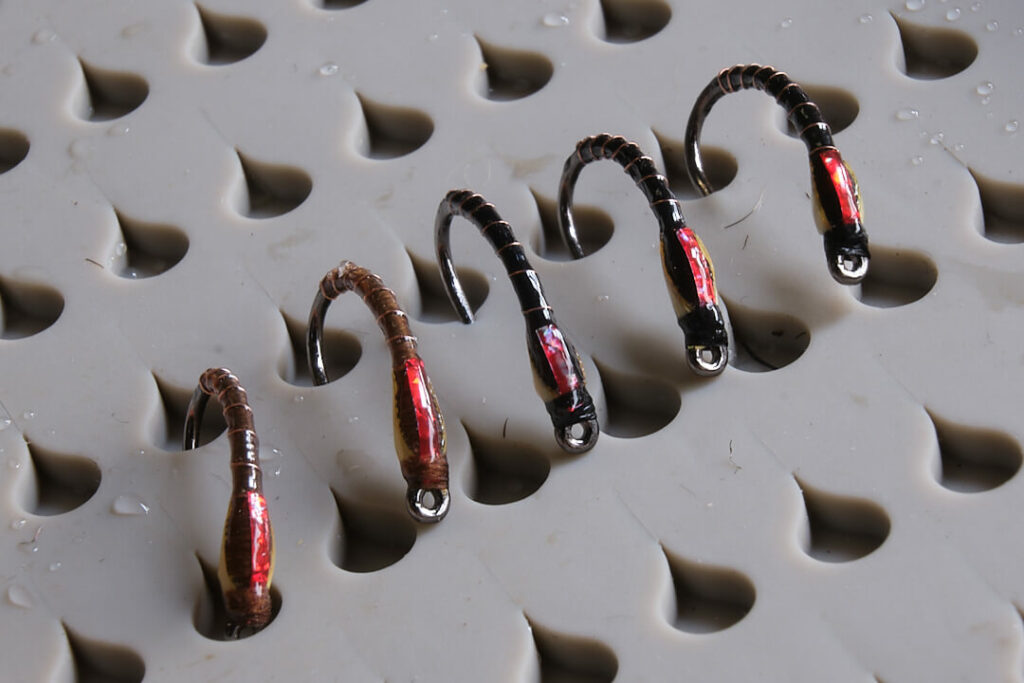
This single fly could be a full book in itself. It’s the absolute staple of most trout lakes, but now is the time you absolutely must not be without some buzzer patterns in your box.
What follows in the paragraphs below is a generalisation, so I’ll put this backstop in that every lake can have its own subspecies of buzzer, which you would only ever see at that fishery. Some of these can be massive. Even up to Size 6 or 8. You’ll learn this as you get more familiar with a venue.
On a similar note, some subspecies will be active at entirely different times to the norm. In general, buzzer fishing may be best in the afternoon in spring, but some won’t hatch until 9pm. On one lake I fished used to have these giant things come off just before midnight and fill the moonlit sky like a World War Two parachute landing.
Don’t get bogged down looking for super flashy flies with all manner of sparkle and glisten. Keep it dead simple. In spring, black is the key colour. Around a Size 12. Smaller in summer. And if not black, then olives or browns.
A simple thread body, wire rib and orange cheeks are the basis of the pattern. Varnished to protect it from sharp teeth. I put a tiny piece of holographic tinsel over the top of the thorax just in case the sun pops out, but you’d barely know it was there.
I’d be lying through my teeth if I said I wasn’t drawn to some of the tying’s you see. My tying drawers are riddled with rash material purchases from a session of watching Davie McPhail. But buzzers aren’t the fly to get taken down the must-have material rabbit hole. Thread, wire, varnish.
Fly tiers become fascinated by all the latest types of resins and materials to make some phenomenal looking Buzzers, which in truth are more of an art form that interests humans more than fish. The key thing is how you fish buzzers. And as long as you have roughly the right size and colour, you are most of the way there. The rest is how you present them. And where.
Literally anywhere on a lake could hold fish that would take your fly. But my first port of call would be areas where the bottom is marginally shallower than the rest of the lake. For example, the water in bays tends to be more buzzer friendly. If the wind is blowing into that bay, then definitely give it a few casts.
Another thing with buzzers is that their infant version, the bloodworm, requires very little oxygen where it lives on the bottom. Meaning silty or sandy areas can be very good. You can find some areas of a lake fish better than others year after year, and this may be one of the key reasons.
Wind is another factor. The ideal being a corduroy ripple. Not a wave. And also not flat calm. If the weather forecast is showing 5 to 10mph winds with cloud cover, your mouth should start watering.
I prefer to avoid casting straight across a side wind as the bow in the line makes the flies pull round too fast once it gets up a head of steam. The key with buzzers is generally extremely slow and patient. So if you have a choice, cast more downwind with a slight angle. A mild bow in the line is perfect.
Fishing the bank with the wind behind you is fine as well. But rather than cast straight down the wind, where the line would be inclined just to stay in the same place, try to cast 20 or 30 degrees either side of straight and let the wind put a tiny bit of tow into the line.
Once the flies are out there, make sure you are in direct contact immediately and watch the end of the fly line for fish taking on the drop. This is why you will see some anglers with permanent marker stripes drawn on their fly lines – they really highlight little shudders better than a monotone colour.
Once at the depth you are happy with, aim for two things regarding retrieve. Make it JUST fast enough to stop kinks in the line forming from water movement – although many anglers use these as their take indicator when they pull tight. And also make it so slow that you aren’t really moving the flies. The best way to describe this would be a static retrieve, where you can keep the flies at a depth using tension. Or put much more straightforwardly, just do a very, very slow figure of eight.
Over the course of each cast, I also do about three very slow one-metre strips that cause the flies to rise in the water and fall back down again. Just like the real pupae do. Some people speed up the figure of eight for three or four seconds with the same results. Many takes will come just after you’ve done this and the flies are dropping back down.
If you get the take most people associate with buzzer fishing, you’ll not be in much doubt something has taken. Even with a funereal paced retrieve they can give you the fright of your life. If you’ve ever heard fly fishers say the tug is the drug, it probably came from someone using buzzers.
You can fish buzzers under the indicator as well, and in truth this can be absolutely lethal once you have keyed into depth. But you are missing out of the real fun of those smash takes.
For a basic straight lining set up for drifting buzzers, I would only tend to have two flies to avoid complications with tangles using three may bring. Let’s say a 15ft leader of 5.9lb Edge Tackle Fluorocarbon Pure, with the dropper five or six foot up from the point fly. I would tie this dropper with a figure of eight knot, but use whatever knot you are used to and happy with. A Cadence 10ft #6 is flawless for this job.
And a word here about the ideal fly line for buzzer fishing – of all the praise we have had for our Cadence Floating Fly Lines, the ever repeating one is just how good a buzzer line they are. The core stretch is bang on the button, and the slightly lower thickness than other lines means they don’t pull round quite as quick. The lack of memory is also a very beneficial attribute – unless you use that to spot the gentler takes, of course.
Even if you don’t own a Cadence fly rod or reel, the fly line should absolutely be top of your list when the buzzers are on the move. It’s unbeatable for this job.
To finish off with some fly tying notes, if you want white breathers coming out the head of your fly, I use a type of tying thread called Uni Stretch (white) – it is the perfect material for this task. It’s knocked every other alternative to one side for me.
An absolute doddle to work with, doesn’t give too much build up and when cut short is really nice and fluffy without the need to do extra work with it. It looks extremely realistic as well. Just use a strand doubled over once and you’re done.
Many people are happy using UV torches and resins for speed and ease, but I can’t get away with them as it thickens the body up a little too much, so I use several coats of varnish instead. This draws the process out a lot longer, but the flies stay a little leaner. I’m not sure the fish are super bothered by the slightly different look, but an ultra-varnished fly will sink quicker than thicker bodied ones. There are advantages to both fast and slow sinking buzzers, so this isn’t a negative. There may be a time when the fish are only taking buzzers in the top couple of feet, and one that sinks like a stone is out of the kill zone in a matter of seconds.
The final point is the type of hook. Let’s narrow it down to an either or.
You could use a purpose-built buzzer hook. And this will make your fly look much more like the real thing with that buzzery bend to it. But a word of warning here, these hooks can cause line twist, so I prefer to use them on the point rather than the dropper, which I want to remain as intact as possible. The clue would be when you dunk the fly in the water after fishing a cast, and it spins – just re-centralise the knot, as a knot that has slipped around the eye may be causing it to swim a little off kilter thus causing the twist.
You could also use a standard hook and just dress the fly along the straight shank. This has less of an issue with spin. I would fish one of these on the dropper.
And finally, on the subject of buzzers, I’ve cheated here because I’m going to put Wicked White in this section as well as Black Buzzer. Buy or tie both.
The Wicked White may look like the most basic form of fly ever tied, but this is what buzzers can look like at a certain stage of their cycle. The white spot certainly seems to be a key trigger and can be a big difference maker. As can the orange cheeks on the normal buzzer.
Hawthorn or Black Gnat (Dry Fly)
Perhaps a generalisation, but if you just want to pick one from a catalogue, go for a Black Hopper.
It’s the best cross-section of the land-born flies you are likely to come across in spring, without being one in particular. The key ingredients are colour and the dangly legs.
Look at how the natural flies are sitting on the surface – you are bound to have been in the situation where you are surrounded by rising fish, but none of them so much as look your way. And you know, unquestionably, they can see your fly.
The first thing to look at is how your fly is sitting relative to the surface film.
If the natural hawthorns or gnats are sat on top, and your fly is partially under, partially in and partially on the surface, you have a lot of the answer.
Put simply, if part of your fly so much as goes under the surface and 500 other natural flies are skating around on top, you need to change your presentation. Flies like a Griffiths Gnat may not look like a Black Gnat, but they behave more like one on their tiny little stilts on top of the water.
Think of what the fish sees from underneath rather than what your human eye sees from above.
For dry fly leader material, I prefer old-fashioned monofilament rather than fluorocarbon as I think it leaves less of a footprint and isn’t as stiff, but we’re on an entirely different subject here.
Try to match leader thickness with the size of hook you are using as well. Small flies, thinner leader etc.
Hawthorns and Gnats tend to hatch in the warmer part of a spring day rather than the evening. A warm late morning or early afternoon in April is about your best chance, depending on the fishery.
And Hawthorns and Black Gnats are land born insects. So you don’t need to worry about their pre hatch lifecycle like buzzers or olives. They just fall onto the water as full-blown adults in any kind of breeze. Which is where most people stop considering their use to a fly fisher. But what about when the fish stop rising and most anglers go back to lure fishing? You might be missing a trick.
Most of these flies will end up dead on the surface and eventually get mixed up by the wind underwater. The longer they’ve been stuck on the surface, the more likely they are to be in bits and pieces underwater later on. Go to the downwind bank and fish your black hopper very slowly subsurface. Some fish will be sweeping these up when they are blown downwind. Any small black fly, such as a Black Pennell, Black Spider or Black Hopper fished subsurface will do lovely.
Top Hat/ Suspender Buzzer
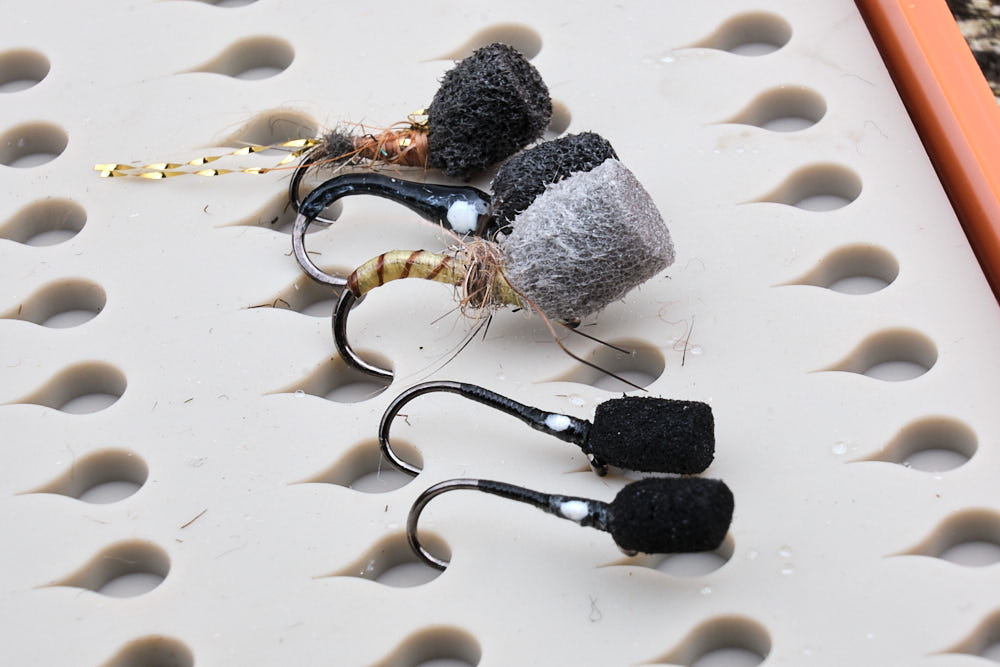
Use these when buzzers are hatching into midges, and you can see fish heading and tailing everywhere. This rise form tells you the fish are taking flies in the surface film, not on. (They tend to make more splashy rises when taking adult flies off the surface, as a very approximate rule).
The Top Hat or Suspender Buzzer represents a hatching insect, which is its most vulnerable stage to the trout. The surface film can act like glue to a tiny insect, and they get stuck, basically. It’s one of the reasons you may see more fish on top in a flat calm, than in a wind when the surface is broken and the fly can hatch off and escape quicker.
This fly covers that stage and is one you really need in your box all year around.
My favourite is a Wicked White style, with a grey foam head. But have a look at what is hatching if you can.
Other alternatives are Hares Ear bodies, Yellow Owl or plain olive as generalisations, but every water is different and has its own colours and sizes.
I’ll spend a bit of time getting the balance of floatation and hook weight correct, and am not too bothered about seeing the fly when it’s fishing. As long as I know where it is and that it’s at the surface is good enough. You may prefer to have a visual, though.
You want enough floatability in the fly to stop it sinking after moving it on the surface. But not enough to float like a cork and act like a small yacht sail.
I tie my top hats with too much foam initially and use scissors to clip them down until they sit and fish right. Tie them with too little foam, and you have a sinking fly from cast one.
Cast a couple of yards in front of rising fish, strip the line to make sure you are in touch with the fly, count to three and cross your fingers.
If there are no fish rising, they can still come up for a top hat, but you might want to put a little more movement in the fly occasionally to advertise its presence.
Shipman’s Buzzer
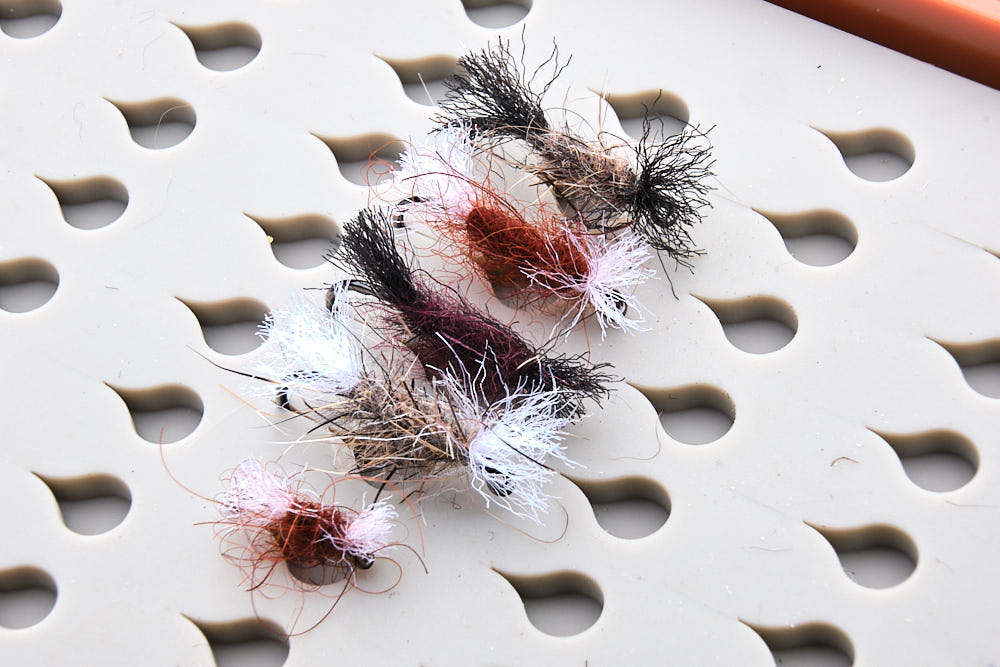
A fly originally tied by Dave Shipman way back when to represent buzzer shucks after the fly had hatched and left its old coat behind. It tends to be fished on the surface as a true dry fly and I suspect the fish take it because of the way it behaves rather than as a buzzer shuck a lot of the time. If you aren’t catching on a top hat and the fish are still showing on top, change to one of these.
Or why not try one of each on the same cast?
Alec Harvey’s Nothing Fly is along these lines and just as lethal.
Size 14 should cover most eventualities in spring.
An absolute doddle to tie and time served over many decades, its one fly that hasn’t been consigned to the history books for very good reason.
I prefer an all black version, but will fish hare fur varieties or the original fiery brown. Learn what is best for your fishery.
Diawl Bach
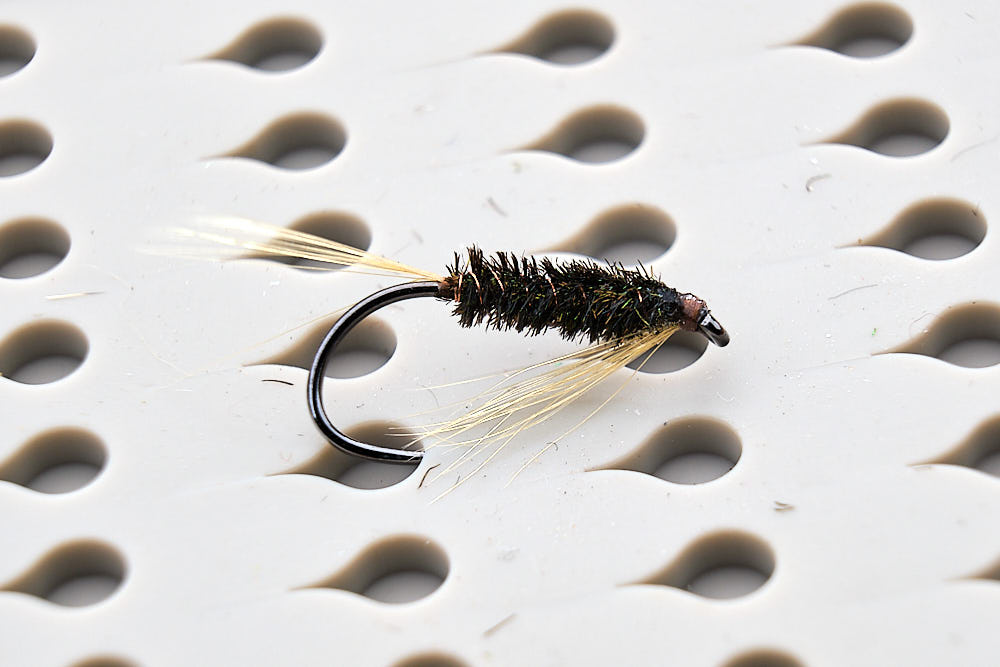
The number of words in this section will not do this fly justice. It is one of the most important flies that have ever come to prominence over the decades. You definitely have to have some in your box.
You can fish them dead slow like Buzzers (see above), put them on the droppers of a washing line or pull them back using a Blob as the attention grabber on the top dropper. Fish them as a basic single nymph and weight or unweight them.
There must be thousands of Diawl Bach variations, but I still like the original with no additions. The most common variation is perhaps the Red Holographic Diawl, but quite honestly you can go for whatever tickles your fancy.
It’s the general profile that is key alongside the peacock herl body. It just looks like an insect when wetted down underwater.
Cove Pheasant Tail Nymph
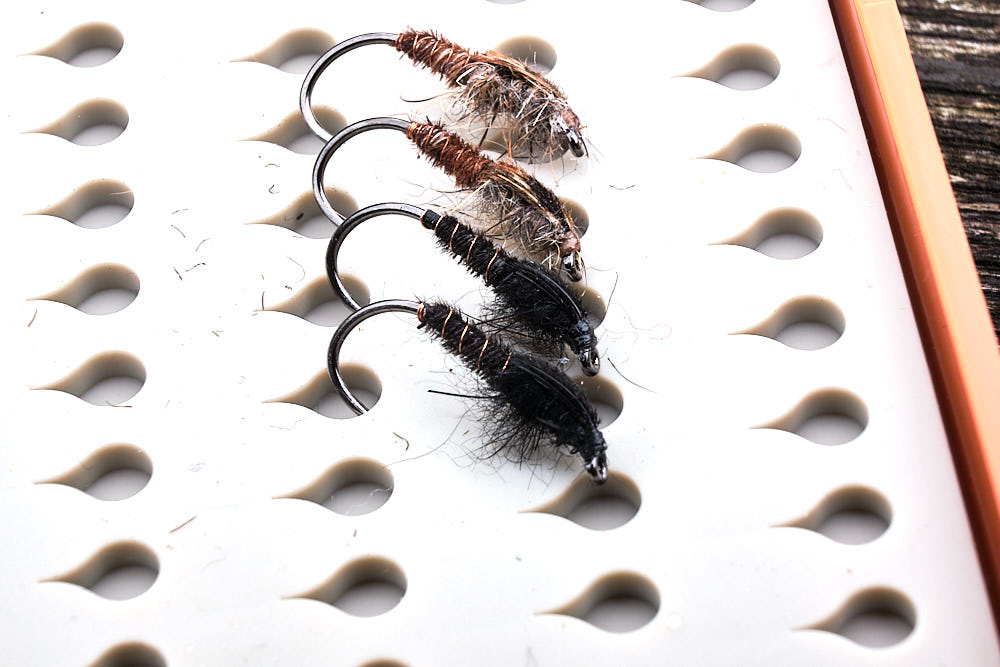
Similar magical properties to the Diawl Bach, really. These are taylor made for spring as I think they represent general nymphs but also err towards buzzer pupae as well. If you are unsure which nymph to try, go with one of these.
They include two of the great fly materials in pheasant tail and hare/rabbit fur.
Take on board every word said for Diawl Bach above and apply it to the Cove Pheasant Tail. They’re great flies. Fish them just the same.
Perhaps a little prone to trout teeth damage, no matter how much wire you pin the pheasant tail fibres down with, it is a sacrifice I’m happy to make due to their sheer effectiveness.
They are an easy fly to make, so I don’t mind using one or two a session.
Mossback Nymph
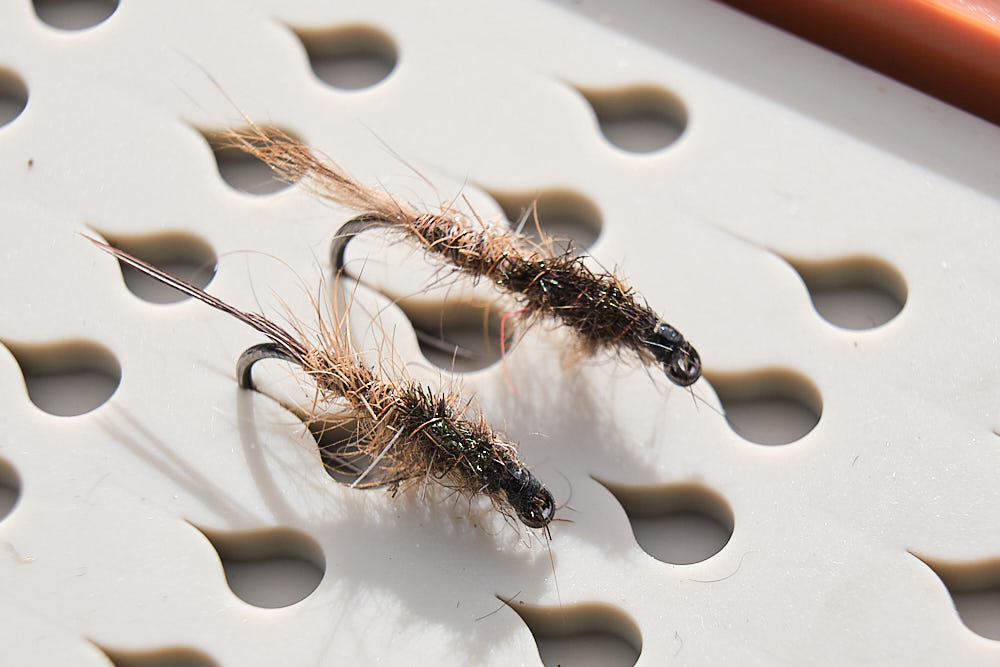
The final nymph in this triple-header.
Once again, it’s a similar story with how to fish it alongside the Diawl and the Pheasant Tail.
This fly combines the magic of a hare/rabbit fur body with a peacock herl in the head.
From staring down microscopes at freshwater insects many moons ago, one trigger point that appeared in so many was a slightly darker head area fading into a lighter body. The Mossback Nymph delivers that perfectly. It’s a fly I have the utmost confidence in, despite it being a name you will struggle to find in the shops. It’s nearly a Hares Ear but different enough not to be one. I prefer the Mossback to those and tie them in all shapes and sizes.
Perhaps this fly is going more towards general olive/damsel/mayfly nymph territory and away from buzzers a little, which is great at this time of year. There are plenty of insects active underwater in spring that aren’t buzzers, so that’s fine.
Apps Bloodworm
Probably the most popular fly on small stillwaters for a good reason. Use the four-legged standard version with the glo-brite body or the 8 legged pulling version. To save me covering the same ground, I’d advise going onto Alec Harvey’s YouTube Channel and looking up the Peter Appleby video, where he shows exactly how to tie it and fish it.
You definitely need some of these in your box in Olive, Amber and Blood Red when the more natural flies aren’t working.
It’s a year round fly really, but I wanted a couple of alternatives to the naturals already covered to balance up the spring selection. The Apps in all its forms has to be in the group of ten flies, therefore.
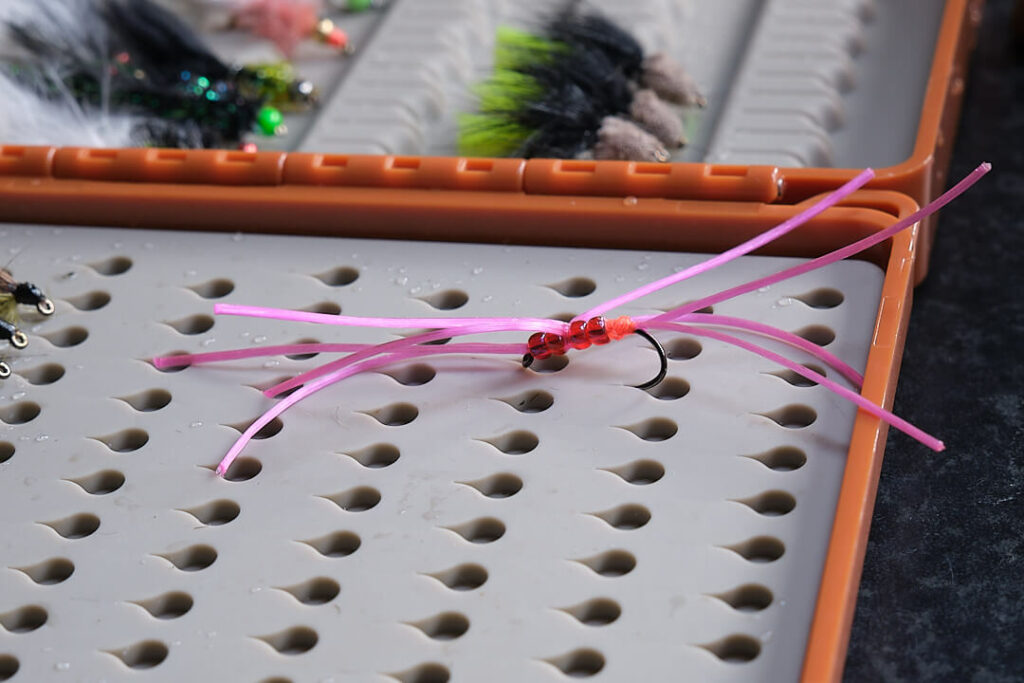
Slushy Bug
Another more gaudy creation to add some colour to the spring list. The water is still cool at this time of year and lures are still a factor.
A go-to tail fly for fishing under an indicator. This is my version of an Eggstacy Worm but using FNF Slush Jelly instead of Eggstacy. It’s tied on a jig hook with a 3.5mm tungsten bead and fished under an indicator I designed and make myself.
This is the fly I tie for customers more than any other.
Both are great materials, but the FNF Slush just holds a little more rigidity when using tails on a pattern and tangles round the bend far less. Which is nice to know if the flies are likely to be out for a long soak between casts. It also comes alive in water and pulses almost like a mini snake when not being retrieved.
If you only have Eggstacy and tie flies yourself, just whip in a loop of old leader line near the bend of the hook that will stop the material collapsing over the hook. I use both materials and over time the best FNF Slush is called ‘Blue Cheese’ but I’m also pretty happy with the Peach Eggstacy version. There are loads of colours to try out, though. Black is always a good Plan B and I have a couple of friends that swear blind the Spearmint Mojito Eggstacy is on another level.
One point to note when tying the tail on is don’t get too carried away. I put mine in so they are 1.25in in length – measured from the bend of the hook. Once FNF Slush is wet through the tail length will increase quite a bit, so consider it will be different when you fish it from what left the vice.
You can also double this fly up as a pulling fly with a few tweaks:
Increase the tail length 1/4 to 1/2 of an inch. And certainly drop the bead weight a little. Maybe 3.0mm and under in tungsten terms. I also tie it on conventional hooks rather than jig hooks for pulling. About a size 10. Fish as fast or slow as you would with a standard lure.
And one thing is for sure with Slush – the material looks far better in the water than in a fly box, where it can look quite uninspiring.
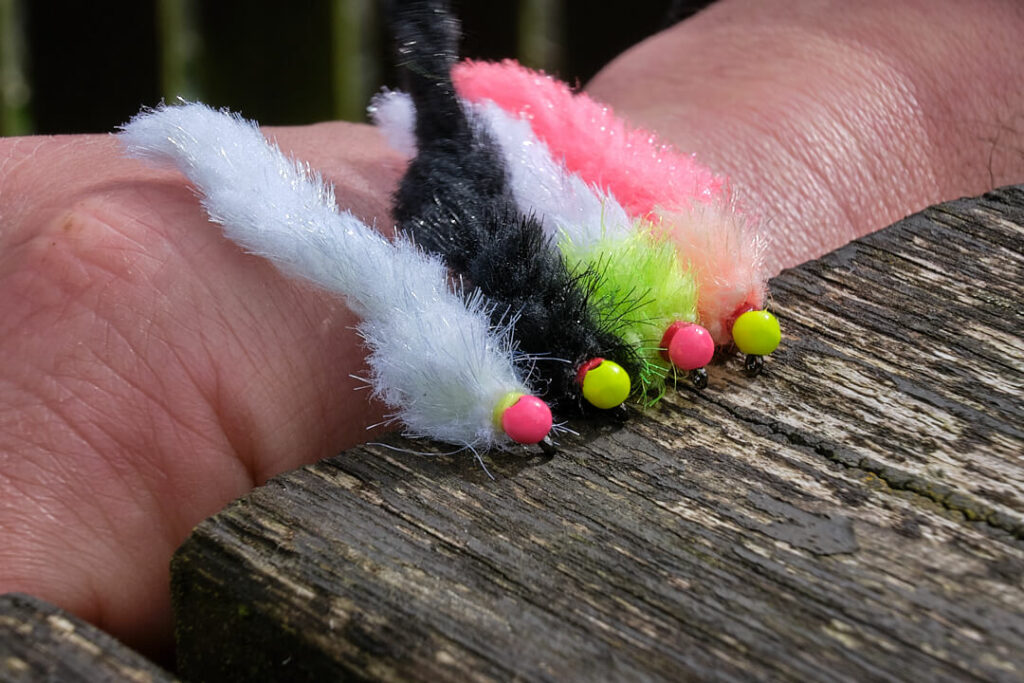
Black Cats Whisker
We need one final fly to cover as many springtime bases as possible. And this could easily have been a 5cm Black Snake.
I wanted a black lure of some kind in the list as we are still prone to very heavy rain at this time of year and I do believe black is the colour that stands out best in muddy water. It’s a much more solid colour than say orange. Have a look for yourself and decide.
If the visibility is down to centimetres, it is perhaps beneficial to have a couple of silly leg horns sticking off the front as well. To add some vibration in the water for want of a better term.
Salmon anglers use boar bristles and overall, it’s a subject I’m not a hundred per cent sure about. But suspect something a little more rigid in the dressing might make a ‘noise’ to nearby fish a little more. Even thicker fishing line might do the job?
And regardless of whether it makes a difference or not, if naturals are out of the equation due to coloured water I’m happy to work on this theory if it builds confidence out of curiosity.
This insurance policy fly has less weight than a standard lure so I can retrieve slower alongside its daft horns and a Lureflash Mosaic Fritz body, which I already know is a slight difference maker.
About Stuart
Stuart is a fully qualified fly-fishing instructor available for half or full-day lessons. He can also tie flies to order, but these are strictly limited and may take a while as they are all personally tied and not bought in.
To book a lesson or make an enquiry, contact him through his Facebook page here:
Find Stuart on Facebook by clicking here.
Email: stuart@cadencefishing.co.uk

